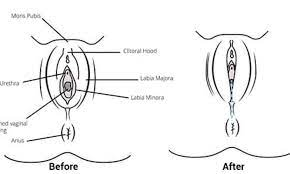INTRODUCTION
A labiaplasty is surgery to reduce the size of the labia minora – the flaps of skin either side of the vaginal opening.
It should not be done on girls younger than 18 because the labia continues to develop beyond puberty into early adulthood.
Some women want a labiaplasty because they do not like the look of their labia. But it’s completely normal to have noticeable skin folds around the opening of your vagina. In most cases, it does not cause any problems, which is why labiaplasty is rarely available on the NHS.

INDICATIONS
Having a labiaplasty is a big decision that you should think about carefully. It can be expensive and carries a number of risks.
There’s also no guarantee you’ll get the result you expected, and it will not necessarily make you feel better about your body.
If you’re thinking about having a labiaplasty, discuss it with your GP first.
You may have a condition that’s causing discomfort, which can be treated. Or there may be a reason why the operation is not suitable for you.
Your GP may advise you to speak to a counsellor or psychologist before committing to surgery.
You cannot usually get a labiaplasty on the NHS
A labiaplasty is not usually available on the NHS. But it may be offered in some circumstances – for example, if the vaginal lips are abnormal, to repair tears after childbirth, or to remove cancerous tissue if a woman has vulval cancer.
Choosing a surgeon
If you’re having a labiaplasty in Dehli, check with the Care Quality Commission (CQC) to see if the hospital or clinic is registered with them.
All independent clinics and hospitals that provide cosmetic surgery in Dehli must be registered with the CQC.
Be careful when searching the internet for labiaplasty surgery. Some clinics may pay to advertise their services on search listings.
Check the surgeon is registered with the General Medical Council (GMC). They should be listed on the specialist register and have a licence to practise.
Also, check the British Association of Plastic Reconstruction and Aesthetic Surgeons (BAPRAS) or the British Association of Aesthetic Plastic Surgeons (BAAPS) to see if the surgeon is a “full member” on the specialist register for plastic surgery.
Always book an appointment to meet the surgeon before the procedure.
Ask your surgeon:
- about their qualifications and experience
- how many labiaplasty operations they’ve performed
- how many operations they’ve performed where there have been complications
- what sort of follow-up you should expect if things go wrong
- what their patient satisfaction rates are
ecovery
You may need up to 2 weeks off work to recover. It can take a couple of months for the skin to fully heal.
During this time you need to:
- keep the area clean and free from infection
- wear loose underwear and clothes to prevent rubbing
- avoid sex for about 6 weeks
- avoid physical activity for 6 to 12 weeks
- use sanitary towels instead of tampons for a few weeks
Your surgeon may give you more specific advice to follow.
Side effects
It’s normal after a labiaplasty to have soreness, bruising and swelling for up to 2 weeks.
During this time, peeing and sitting may also be uncomfortable. You’ll be given painkillers to help with this.
What could go wrong
A labiaplasty can occasionally result in:
- bleeding
- infection
- scarring of tissue
- reduced sensitivity of the genitals
Any type of operation also carries a small risk of:
- a blood clot in a vein
- an allergic reaction to the anaesthetic
Your surgeon should explain how likely these risks and complications are, and how they would be treated if you have them.
What to do if you have problems
Cosmetic surgery can sometimes go wrong and the results may not be what you expected.
Speak to the surgeon at the hospital or clinic where you were treated if you experience complications after having a labiaplasty, or you’re unhappy with the results.
PROCEDURE
Labia minora reduction surgery, or labioplasty, is a remodeling of the enlarged inner lips of the vulva. Enlargement of the labia minora may be apparent from childhood, but most often it is acquired, caused by childbirth, age or infection. It may bother the patient in a functional (wearing clothes, during sports) or in an aesthetic way. The procedure removes skin and mucosa in a way that the scar is barely visible. The procedure may be combined with a clitoral hood reduction (removal of the skin excess around the clitoris) and labia majora surgery.
FAQ
Q1 What is labiaplasty?
A1 Labiaplasty is the reduction of the labia minora, the inner portion of the labia, so that it does not hang below the labia majora, the outer portion of the labia. While this condition is benign, it may result in self-consciousness and/or discomfort when you exercise or wear tight-fitting clothes.
Q2 What happens at my initial labiaplasty consultation?
A2 At your first consultation, Dr. Ortiz will discuss your symptoms and perform an examination to determine if you are a good candidate. If he determines labiaplasty would be beneficial for you, he will discuss surgical techniques with you.
Q3 What are the different labiaplasty techniques?
A3 There are two techniques used in labiaplasties: the wedge technique and the edge technique. The wedge technique involves removing a V-shaped “wedge” from both sides of the labia and stitching the edges together. This technique causes the least amount of scar tissue. For the edge technique, Dr. Ortiz will make an incision that removes the outer edge of the inner labia, making the inner labia even with or shorter than the outer labia. This technique creates a cylindrical scar and more scar tissue than the wedge technique.
